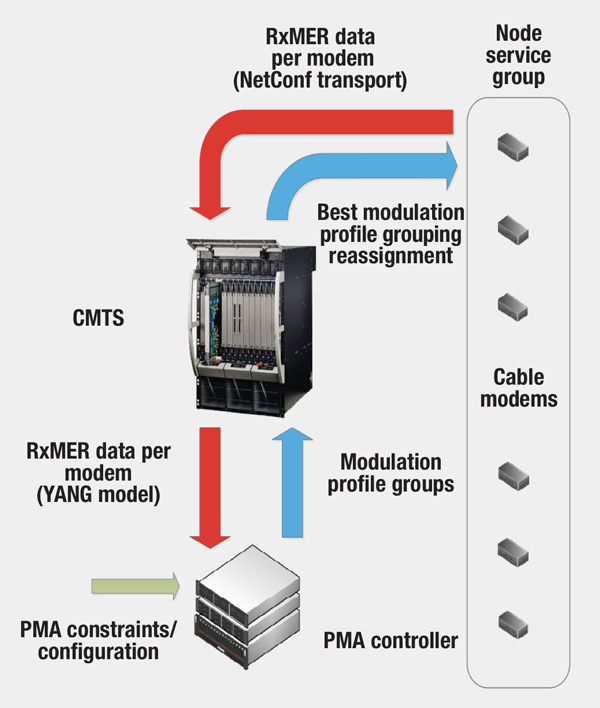DOCSIS 3.1 Profile Management Application
By Roger Stafford
Making the Most of Your HFC Network, Bit by Bit
Increasing network capacity is a major point of commercial and operational focus for any network operator. There have been two primary methods to achieve this since the introduction of DOCSIS on HFC networks. The first has been to increase the available spectrum. Over the past 50 years there have been incremental jumps in the downstream upper frequency band edge from 220 MHz to as high as 1.2 GHz, using relatively expensive plant hardware reconfigurations and upgrades. The second method has been by increasing the modulation rates within each channel (QPSK, 64-QAM, 128-QAM, 256-QAM) which has taken place as intermediate steps between the incremental jumps in available frequency ranges.
The Profile Management Application has recently become available as a means to increase network capacity in a way that DOCSIS 3.1 has made possible.
This go-higher, not wider PMA strategy is taking advantage of that fact that cable operators have been consistently and systematically cleaning up the amount of impairments on their networks. Driving fiber deeper has also improved signal levels and quality. In many cases the amount of available receive modulation error ratio (RxMER) at each modem is either not fully recognized or is not being used. DOCSIS 3.0 network planners are forced to design around the lowest RxMER at any modem on a node or in a service group, which is typically 30 dB to 33 dB. Now, system designers have a new tool at their disposal that takes advantage of unused RxMER for those modems that have better conditions than the worst case. Using that headroom had not been particularly easy until availability of the capabilities offered by PMA.
Adaptive modulation rates are not new within telecommunications. DOCSIS 3.1 introduced the possibility to offer a range of modulation rates in the downstream path of 512-QAM to 4096-QAM (with an option for 8192-QAM in the future). So far, some operators that have launched a DOCSIS 3.1 service have opted for a conservative 1024-QAM in the downstream because the powerful LDPC forward error correction (FEC) in DOCSIS 3.1 usually supports 1024-QAM in a network where DOCSIS 3.0’s 256-QAM was previously used with Reed Solomon FEC. This effectively increased the spectral efficiency from 6.33 bits/s/Hz up to 7.92 bits/s/Hz (25% increase). The problem for network operators is that the best carrier-to-noise ratio available at some modems (typically 36 dB to 40 dB) has not been usable.
The aim of PMA is to maximize the signal data rate at each cable modem using a closed-loop system, and network efficiency improves when each device is operating at its maximum possible speed.
PMA is largely a software-based implementation that allows any unused carrier-to-noise ratio to be exploited by a DOCSIS 3.1 system.
The introduction of DOCSIS 3.1 meant a potential for a 40% increase in network capacity, by upgrading the CMTS, amplifiers and cable modems. PMA offers a network capacity increase on top of those D3.1 gains, by as much as 40% without any outside plant hardware upgrades.
Measurements taken by cable company engineering groups on early DOCSIS 3.1 systems has shown that the majority of cable modems can be operated up to 4096-QAM without any further plant modifications, but others in the same service group would need to be operated at a lower modulation such as 2048-QAM or 1024-QAM. There is a net benefit of increasing the network efficiency by always maximizing the modulation rate to and from each modem in the system. It reduces the potential for traffic congestion and raises the bar for when the network would saturate.
HFC network operators have to deal with a variety of impairments and conditions that affect overall performance and the ability to use higher modulation orders. Examples include ingress interference, burst or impulse noise, equipment misalignment, carrier-to-noise and carrier-to-distortion ratio degradation in longer cascades, poor frequency response caused by impedance mismatches, and so on. PMA acts to compensate for these impairments. A single closed-loop cycle of the PMA algorithm will adjust modulation rates for optimum performance in given conditions, establishing a baseline of sorts. Any subsequent runs of the algorithm will adjust for changes that occurred after the baseline was established, such as for cable attenuation variations due to daily changes in ambient temperature. The closed-loop PMA cycle operates on a regular schedule and allows operators to maximize network capacity for any long- and short-term changes in the plant environment.
Cable operators realize that increasing the capacity in the upstream is just as important as increasing the downstream capacity. Another benefit of PMA besides maximizing the downstream capacity is that the same technique can be applied to the upstream path by also operating the OFDMA channel(s) in the same closed-loop way. While this is effectively a second control-loop operating independently of the downstream controller, it offers the similar net gains in capacity. For both upstream and downstream channels, modems are ranked by RxMER, and the controller applies a K-means test to produce groupings that fall into modulation profiles. The controller then reassigns, via the CMTS, all of the modems within the service group into their respective sub-groups by modulation profile.
PMA applies to two types of plant topology:
- The traditional iCMTS version — the CMTS is located within the headend infrastructure and is typically farther away from the modems it serves compared to the newer DAA topology. In the iCMTS topology, PMA will no doubt give the greatest increase in data capacity because the variation in end-of-line modem SNR is also the greatest.
- In a DAA topology, the eCMTS or vCMTS functionality is placed further down the distribution chain, into the field, and the average RxMER at modems is higher.
Nevertheless, PMA will maximize the variations across any network topology. In addition, PMA gives a much greater visibility of the actual operating conditions experienced by modems, and effectively manages their performance relative to the plant’s optimal operating conditions at any point in time. An operator that is able to observe both the static condition for all end-of-line devices, and the dynamic variations that are occurring to all devices means they become much more informed about where to apply changes to their network.
Almost certainly, static PMA will yield the greatest step change in performance. Dynamic trims the network to take account of daily and hourly fluctuations in RxMER as seen at every modem.
In the future, as a further extension, PMA could adjust modulation at the millisecond granularity to make D3.1/D4.0 adaptive to very short duration interference sources such as FM and LTE network ingress.



Roger Stafford,
Principal Architect,
Charter Communications, Inc.
roger.stafford@charter.com
Roger Stafford’s career in the television, cable and satellite industry began in 1983. He holds the position of Principal Architect within the DOCSIS Advanced Engineering group at Charter Communications Inc, where he works to evolve state-of-the-art broadband technologies from the ideas stage through to field-deployments. Roger holds a Bachelor of Engineering Honors Degree in Electrical & Electronic Engineering, and a Master of Science Degree in Aviation Sciences.
Shutterstock




